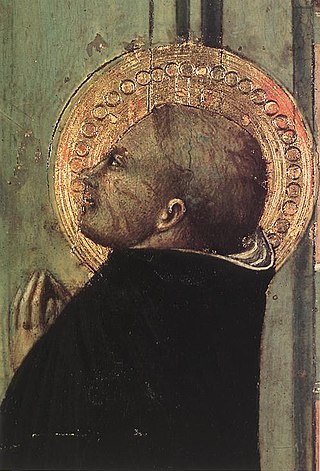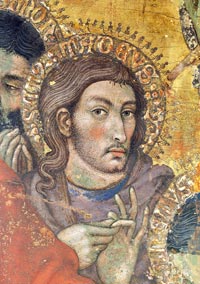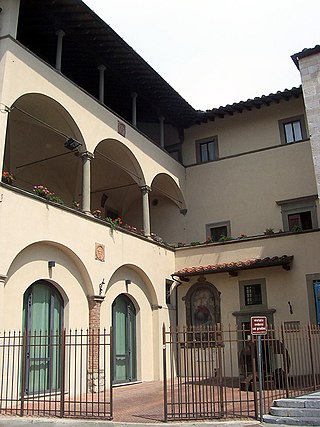
Arezzo is a city and comune in Italy and the capital of the province of the same name located in Tuscany. Arezzo is about 80 kilometres southeast of Florence at an elevation of 296 metres (971 ft) above sea level. As of 2022, the population was about 97,000.

Andrea Mantegna was an Italian Renaissance painter, a student of Roman archeology, and son-in-law of Jacopo Bellini.

Piero della Francesca was an Italian painter, mathematician and geometer of the Early Renaissance, nowadays chiefly appreciated for his art. His painting is characterized by its serene humanism, its use of geometric forms and perspective. His most famous work is the cycle of frescoes The History of the True Cross in the Basilica of San Francesco in the Tuscan town of Arezzo.

Luca Signorelli was an Italian Renaissance painter from Cortona, in Tuscany, who was noted in particular for his ability as a draftsman and his use of foreshortening. His massive frescos of the Last Judgment (1499–1503) in Orvieto Cathedral are considered his masterpiece.

BartolomeoMontagna was an Italian Renaissance painter who mainly worked in Vicenza. He also produced works in Venice, Verona, and Padua. He is most famous for his many Madonnas and his works are known for their soft figures and depiction of eccentric marble architecture. He is considered to be heavily influenced by Giovanni Bellini, in whose workshop he might have worked around 1470. Benedetto Montagna, a productive engraver, was his son and pupil and active until about 1540. He was mentioned in Vasari's Lives as a student of Andrea Mantegna but this is widely contested by art historians.

Pietro Perugino, an Italian Renaissance painter of the Umbrian school, developed some of the qualities that found classic expression in the High Renaissance. Raphael became his most famous pupil.

For the village near Livorno, see Sassetta, Tuscany

Taddeo di Bartolo, also known as Taddeo Bartoli, was an Italian painter of the Sienese School during the early Renaissance. His biography appears in the Vite of Giorgio Vasari, who claims that Taddeo was the uncle of Domenico di Bartolo.

Arezzo Cathedral is a Roman Catholic cathedral in the city of Arezzo in Tuscany, Italy. It is located on the site of a pre-existing Palaeo-Christian church and, perhaps, of the ancient city's acropolis.

The Annunciation of San Giovanni Valdarno is a painting by the Italian Early Renaissance master Fra Angelico, painted c. 1430 to 1432 in tempera on panel. It is part of a series of Annunciation panels painted by Fra Angelico in the 1430s. The other two are the Annunciation of Cortona and the Annunciation.

The Recanati Polyptych is an oil-on-panel painting by the Italian Renaissance painter Lorenzo Lotto, executed in 1506–1508 and housed in the Civic Museum of Villa Colloredo Mels, Recanati, Italy. The work is dated and signed Laurent[ius] Lotus MDVIII.

The Sanctuary of the Madonna of the Oak or Santuario della Madonna della Querce is a Renaissance-style, Roman Catholic church located about a kilometer from the center of the town of Lucignano, in the region of Tuscany, Italy. The church is in the Roman Catholic Diocese of Arezzo-Cortona-Sansepolcro.

Santi Matteo e Margherita is a Catholic parish church in the frazione of Ortignano in the town of Ortignano Raggiolo, province of Arezzo, region of Tuscany, Italy. The church is part of the Diocese of Arezzo-Cortona-Sansepolcro.

Museo diocesano di Lanciano is a museum of religious art in Lanciano, Province of Chieti (Abruzzo).

The Diocesan museum of Brescia is a museum in Italy dedicated to the artistic patrimony of the Diocese of Brescia, and is located in the greater cloister of the Monastery of Saint Joseph in via Gasparo Salò, a short distance from the Piazza della Loggia.

The Cathedral museum of Prato, Italy was founded in 1967 in a few rooms of the Bishop's residence and in 1976 grew to include items from both the Cathedral of Saint Stephen and the diocesan territory.
The Diocesan museum of Padua displays arts and artifacts belonging to the Roman Catholic Diocese of Padua; it is housed in the 15th-century former bishop's residence or Palazzo Vescovile. The building, adjacent to the Cathedral of Padua, faces the Piazza del Duomo, can in the historic center of Padua, region of Veneto, Italy.
The Museum of Religious Art' is an art gallery and museum in Certaldo, opened in 2001 and one of the town's three museums.
The Diocesan Museum of Palermo is a museum of religious art in Palermo on Sicily, housed in a number of rooms in the Palazzo Arcivescovile opposite Palermo Cathedral.

The Madonna del Popolo is an oil on wood painting by Italian painter Federico Barocci, created in 1575-1579. It depicts the Madonna and the works of mercy. It is signed and dated FEDERICVS BAROTIVS VRBINAS MDLXXIX. It is held in the Uffizi, in Florence.

















